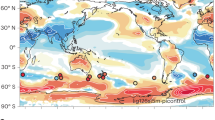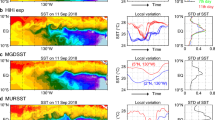Abstract
A substantial anomalous warming of sea-surface temperatures (SSTs) in the tropical Pacific Ocean (an ‘El Niño’) can have profound effects on the atmospheric mid-latitude long waves, leading to severe weather anomalies1–5. However, the magnitude and position of these weather anomalies seem to vary considerably between winters in which El Niño events are in progress2,6,7. In order to forecast with confidence the effects of future El Niño events, it is important to understand the physical reasons for these differences. Motivated by this, we present several atmospheric general circulation experiments which model the atmospheric response to SST anomalies in the tropical East and West Pacific. We have found that the extratropical response to a relatively small West Pacific anomaly can be stronger than and qualitatively different from the response to a much larger East Pacific anomaly. These experiments suggest a possible explanation for the difference in mid-latitude response during the 1976–77 El Niño winter and the El Niño winters of 1972–73 and 1982–83.
This is a preview of subscription content, access via your institution
Access options
Subscribe to this journal
Receive 51 print issues and online access
$199.00 per year
only $3.90 per issue
Buy this article
- Purchase on Springer Link
- Instant access to full article PDF
Prices may be subject to local taxes which are calculated during checkout
Similar content being viewed by others
References
Blackmon, M. L., Geisler, J. E. & Pitcher, E. J. J. atmos. Sci. 40, 1410–1425 (1983).
Quiroz, R. S. Mon. Weath. Rev. 111, 1685–1706 (1983).
Rowntree, P. R. Q. Jl R. met. Soc. 98, 290–321 (1972).
Van Loon, H. & Madden, R. A. Mon. Weath. Rev. 109, 1150–1162 (1981).
Van Loon, H. & Madden, R. A. Mon. Weath. Rev. 109, 1163–1168 (1981).
Wagner, J. A. Mon. Weath. Rev. 105, 553–560 (1977).
Wagner, J. A. Mon. Weath. Rev. 101, 381–386 (1973).
Saker, N. J. Met. Off. 20 tech. Note II/30 (UK Met. Office, Bracknell, 1975).
Lyne, W. H. & Rowntree, P. R. Met. Off. tech. Note II/70 (UK Met. Office, Bracknell, 1976).
Simmons, A. J. Q. Jl R. met. Soc. 108, 503–534 (1982).
Gill, A. R. Q. Jl R. met. Soc. 106, 447–462 (1980).
Hoskins, B. J. & Karoly, D. J. J. atmos. Sci. 38, 1179–1196 (1981).
Simmons, A. J., Wallace, J. M. & Branstator, G. J. atmos. Sci. 40, 1363–1392 (1983).
Corby, G. A., Gilchrist, A. & Rowntree, P. R. Meth. comput. Phys. 17, 67–110 (1977).
Author information
Authors and Affiliations
Rights and permissions
About this article
Cite this article
Palmer, T., Mansfield, D. Response of two atmospheric general circulation models to sea-surface temperature anomalies in the tropical East and West Pacific. Nature 310, 483–485 (1984). https://doi.org/10.1038/310483a0
Received:
Accepted:
Issue Date:
DOI: https://doi.org/10.1038/310483a0
This article is cited by
-
Sea surface warming patterns drive hydrological sensitivity uncertainties
Nature Climate Change (2023)
-
A physical analysis of summertime North American heatwaves
Climate Dynamics (2023)
-
Enhanced jet stream waviness induced by suppressed tropical Pacific convection during boreal summer
Nature Communications (2022)
-
Cross-hemispheric SST propagation enhances the predictability of tropical western Pacific climate
npj Climate and Atmospheric Science (2022)
-
Role of the Bay of Bengal warming in the Indian summer monsoon rainfall trend
Climate Dynamics (2022)
Comments
By submitting a comment you agree to abide by our Terms and Community Guidelines. If you find something abusive or that does not comply with our terms or guidelines please flag it as inappropriate.



